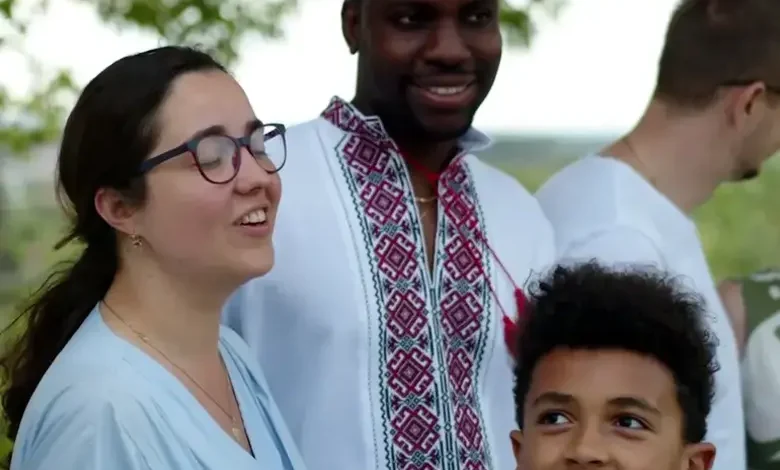Marriages of Ukrainian women with blacks, the euro and English in the future: a video about mobilization caused outrage among the military (video)

Agitation campaigns for mobilization are not a new phenomenon for the Ukrainian information space, especially during a full-scale war. And each time they attract the attention of not only civil society, but also the military themselves, who are direct participants in what the videos or slogans call for. Often, the reaction to similar products is ambiguous. This is exactly what happened with the new video, which was published by the Operational Command “West”. His attempt to paint a future – positive, European, prosperous – caused sharp rejection in some units of the Armed Forces.
The plot of the future as motivation
The clip, which was released by OK Zahid, depicts an imaginary Ukraine of 2062 — a country within the borders of 1991, with the euro as a currency, EU membership and a tolerant, prosperous society. According to the logic of the authors, this is the result of the victory in the war with Russia. It is such a prospect, in their opinion, that should encourage young men to join the army.
At the end of the video, the heroine marries a black man, who symbolizes the multiculturalism and openness of the future society. This emphasis became one of the triggers that caused public indignation of part of the military. However, the criticism of the video is reduced not only to the ethnic context, but also to the general feeling of artificiality, detachment and unsuitability of such content for a real combat motivational field.
Assessment from the military: irritating grotesque and alien reality
Deputy commander of the 3rd separate assault brigade, Lt. Col. Maksym Zhorin published harsh reaction to the video in his Telegram channel. In his opinion, the authors of the product demonstrate a complete lack of understanding of the motivation of people who are on the front lines today. He notes that, according to the logic of the video, the Ukrainian army is fighting for Ukraine’s accession to the EU, English as a second state, and the marriage of Ukrainian women to black men.
This criticism is an indication of the absurdity of the images that the authors chose as symbols of an attractive future. They are not perceived as guidelines, but an unconvincing fantasy that does not take into account the context of war, in which living people die and lose health every day.
Sharply expressed themselves about this video and in the 46th separate air mobile brigade. According to the soldiers, the ending of the video with the “negro son-in-law” is not only an aesthetically questionable decision, but also an example of complete misunderstanding of what the servicemen are fighting for. The subsection explicitly states that such videos look like a “wild disconnection from reality” or an attempt to spend money on a media product without considering its effectiveness or relevance.
“On the screens of the video released by OK Zahid in 2062, the grandfather tells how he fought, how he fell in love, how he lived to join the EU and NATO and the arrival of the euro. The final message: “fight for your future.”
The problem is that we are not fighting for the euro, NATO and a black son-in-law at the 3 minute clip.
We are fighting for survival. For children to go to school, and not die under the rubble of high-rise buildings, to have coffee in the morning and go to work, and not to a bomb shelter. So that our old people live under a peaceful sky.
No one sits under drones in Pokrovsk, thinking about the EU, no one drives BC with “For NATO” patches, no one survived in the mud of Bakhmut, thinking “I wish there were euros in supermarkets now, but that’s not all.”
And the negro son-in-law at 3:17 is the fiercest cringe. There, if you scratch the grandfather’s relatives on the video, you can probably find a lesbian daughter and a gay grandson. We are watching either the laundering of money for “media”, or the fierce detachment of people from reality”, – emphasized in the 46th separate air mobile brigade.
The conflict surrounding the video highlights a much broader problem — the gap between public communication and the actual experience of the army. In a peaceful environment (even a conditionally peaceful, conditionally rear) there is an idea of war as something heroic, historical, promising. On the other hand, for those who are directly involved in hostilities, war is work to the point of exhaustion, losses, life at zero, physical injuries and psychological exhaustion. And when the military sees a glossy picture of a dubious distant future in such videos, they feel only irritation.
This is not the first example of a communication campaign that has caused criticism in society. The problem is not only in style or individual visual details, but in the very principle of developing such products without deep contact with those to whom they are supposed to be addressed or whom they depict. Against this background, the questions arise: who exactly today shapes the idea of war, motivation and the future of our country? Is this how it should be, as shown by the Operational Command “West”?




